Amy Caabay was five years old when her father Pablo died. 34 years later, that fateful day remains vividly etched in the memory of this rice farmer from Roxas, Palawan. She recalls that her father had collected some goldlop peace oyster and other shellfishes near their home by the sea in Taradungan village. He cooked the fish and invited two friends to dinner. A few hours later they had all suffered stomach aches. Pablo was affected worst. His breathing became labored and he died the same day, leaving behind a wife, Amy and her six siblings.
“Since then, I have a lifetime fear of eating shellfish,” says Amy.
Eating toxic shellfish can bring on severe stomach pain, diarrhea, vomiting and even death, within hours. Victims may experience a drop in blood pressure, irregular heartbeat, headaches and short-term memory loss. Some even slipped into a coma. Depending on the type and amount of toxin that entered the body, survivors recover within hours to days. Or not.
Shell fish species like the goldlop peace oyster (Pinctada spp) that killed Amy’s father and the windowpane oyster (Placunaplacenta) are reported to cause poisoning in coastal areas, no thanks to the deadly toxins they imbibe from Harmful Algal Blooms (HABs). The blooms are made up of millions of microscopic two-tailed algae called dinoflagellates, which, when present in dense quantities, appear as clouds of red in the sea. The phenomenon is called “red tide” though not associated with tidal movements. The reddish colors come from some dinoflagellates that have photosynthetic pigments ranging from brown to red.
Palawan scientists have identified dinoflagellates belonging to the Dinophysis, Alexandrium, and Pyrodinium general in the island’s coastal waters. These microalgae are capable of producing “red tide toxins” that cause diarrhetic shellfish poisoning (DSP).
HABs were frequent during the 1990s near the coasts of several Philippine islands, Palawan amongst them. While their frequency has not risen, the number of coastlines affected by HABs is slowly increasing. Also, the types of dinoflagellates and toxins in the HABs have diversified over the years.
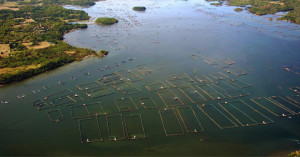
The appearance of HABs is linked to several factors. The main one is the availability of nutrients like iron, nitrogen and phosphorous from sewage and solid waste that are pumped into the sea from human settlements that are eating their way through the delicate coastal ecosystems of the country Effect of red tides on marine life
Effect of red tides on marine life
Red tides on the bountiful shorelines of the Puerto Princesa Bay, such as those favored by veteran fisherman 75-year old Romeo Buenavista, have come to signal danger. “I’ve seen the sea turn red many a time,” he says. “It means the waters can kill fish and human deaths can follow.” Buenavista recalled that his neighbor, a mother and her child, died after eating shellfishes, including windowpane oyster.
That is because HABs can grow rapidly – a process called eutrophication – using up available oxygen from the seawater, depriving fish and other oxygen dependent species in the vicinity, which then die. “Also, high concentrations of these deadly toxins can clog the gills of fish, amphibians and aquatic mammals, suffocating them to death,” says aquaculturist Joven Delgado of the Puerto Princesa City government. In 2010, HABs of Alexandrium and Skeletonima species for two consecutive months were linked to a fish kill in Bolinao and Anda in Pangasinan. During red tides, heaps of dead fish can wash up on shorelines or accumulate in coves, turning the air foul and posing a toxic risk to birds and animals who come to feed on them.
Human settlements linked to red tides
“The muddy beaches smell different during a red tide,” says Leticia Tabudlong of Mandaragat village. Evelyn Suela, who has lived with her parents since the 1940s in the urban coastal community of Quito, agrees. The 56-year old Suela works in a government office in Puerto Princesa, 165 kilometers away from Roxas town.
Suela’s parents migrated to Puerto Princesa from the Negros province in the Visayas, a group of island provinces in Central Philippines, in 1944. The city’s coastline has always drawn informal settlers since the1940s, according to a published study from the Co-Management of Marine Fisheries and Coastal Resources. From only a handful of shanties dotting the bay, the town has ballooned to 9,500 households and 25,000 residents, say the city government’s official records.
Hundreds of shanties have replaced the verdant mangroves, shelf break and seagrass that once lined Puerto Princesa’scoastline. The settlers are mostly fishermen, whose livelihoods are moored to the sea. They choose to live around the banca – the local name for the place where they dock their boats. Their homes are stilt houses built on coastal waters and made of wood, or other local materials. Wooden foot bridges serve as access to these houses. The waves beneath their homes swirl with trash of every kind. Single-use plastic bags, PET bottles, soiled plastic wrappers, sachets, diapers, tin cans and cigarette butts pollute the waters, creating an environment in which dinoflagellates thrive. Studies reveal that these waters have the highest density of bacteria and toxic dinoflagellates that can rapidly multiply and erupt into HABs.

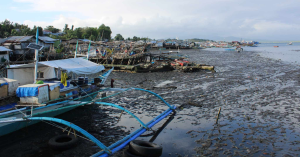
Changing weather patterns linked to HABs
Vulnerability to red tide toxins is escalating for the thousands of coastal informal settlers in Puerto Princesa already exposed to unexpected storms and high waves bought on by a changing climate. In December 2021, tropical storm Odette brought on strong waves one-meter higher than normal, destroying several houses in Abanico.
Scientists say that alterations in the water temperatures linked to changing weather patterns are also contributing to HABs.
“The months that exhibited the highest density of toxic and potentially toxic phytoplankton in Puerto Princesa Bay were June 2018 and January 2019. The next highest density of these phytoplankton was observed in July 2018, January 2019, and March 2019. Interestingly, the recorded incidences of red tide in Puerto Princesa Bay occurred during these months or close to these period, based on the official record of BFAR”.
In some cases, warmer sea surface temperatures during prolonged and strong El Niño events appear to be behind the HAB. Phytoplankton ecology is influenced by the weather patterns. During transitions from dry to rainy weather, Pyrodinium HABs appear. Joven Delgado observes that low salinity and high surface temperature of seawater were the factors contributing to the growing numbers of dinoflagellates. When these factors intersect with untreated wastewater that finds its way into the sea from households that directly discharge untreated wastes into the creeks, rivers, HABs appear.
Delgado said that since last year, a HABs Watch project (mby the Commission on Higher Education (CHED) through its Leading the Advancement of Knowledge in Agriculture and Sciences (LAKAS) in collaboration with various universities in the country has deployed machines in HAB vulnerable sites in the country, including the waters of Puerto Princesa. It utilizes robot technology known as Imaging FlowCytobot (IFCB) that monitors HABs in real-time. He describes it as a proactive approach in predicting the presence of HABs.
“The coastal areas are among the most productive and biologically complex ecosystems in the planet”, says internationally-known mangroves scientist Dr. JurgennePrimavera, chief mangrove advisor of the Zoological Society of London (ZSL). Primavera, who holds BS and MA degrees in zoology and a PhD in marine science, is a widely cited Filipina scientist. She is pushing for the protection and conservation of mangroves underscoring their importance in food security.
The abundance of shellfishes and other fishery resources are a bio-indicator of the coastal ecosystem’s richness. Humans live off that wealth. Picking and gleaning shellfish is an occupation of many in the coastal areas. Locally known as manginginhas, the shellfish gleaners sell their harvest to nearby makeshift stalls called talipapa, or the local market. “Shellfish gleaners are common in our coastal communities, and they represent food security in rural areas in the Philippines,” Primavera said.
A one-liter cup or a kilo of newly-collected shellfish is sold at P40-P120 (0.65 to 1.94euro). Manginginhas like the grizzled 52 year old Victor Miogue of the coastal village of Bancao-Bancaoin Puerto Princesa earn nearly P2,000 to P2,500 (33euros to 41euros) daily. So does Miogue’s neighbor, 47 year old Rolando Almoroto and hundreds of others like him who call the coastal shanties home.
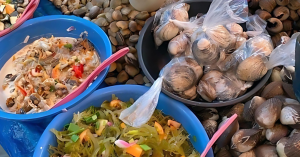
The economic implications of shellfish poisoning in towns that depend on tourism to survive are dire. Puerto Princesa and Palawan are among the Philippines’ premier tourist destinations. Income from tourism touched PHP57.2 billion in 2023, from PHP30.5 billion the previous year, , according to the Provincial Tourism Promotions and Development Office (PTPDO). The economy is built on fisheries. The wide array of shellfishes, including mollusks such as bivalves, clams, oysters and musselsare considered as bounties from their coastlines.
But whenever there are warning advisories of red tide toxins in the water, issued by Bureau of Fisheries and Aquatic Resources (BFAR), Miogue, Almoroto and other fisherfolk cannot enter the waters to collect shellfish.
Five years ago, in July 2019, when red tide toxins were detected in Puerto Princesa, BFAR sounded the alert in a Shellfish Bulletin. Bureau of Fisheries and Aquatic Resources Central Office | Facebook) The warnings appeared with dreaded regularity for nearly five months, till the ban was lifted in October. “We manginghas bore the brunt of the ban. One shellfish gleaner I know suffered the loss of an estimated income of at least P 306,500 (4,900euros) in five months,” recollects Almoroto.
Since January 2024 until April 2024, the BFAR has had to issue at least seven Shellfish Bulletin, the last in May 3, 2024. The ban on shellfish collection usually covers all types of shellfish and species of Acetes locally known as alamang or a type of tiny shrimp because none are safe for human consumption during the red tides.
The most frequent HABs occurred from January to April 2024 in the bays and coastal waters off the provinces of Eastern Samar, Samar, Masbate, Bohol, Zamboanga del Sur, and Surigao del Norte. These are provinces in Visayas and Mindanao located in the central and southern portion of the Philippines. To be removed from the list of red tide – affected areas, the waters from a town or city needs to test negative for red tide toxins three separate times in a week.” Only then can the shellfish ban be lifted in that location, “says Delgado
Solutions
Cleaning trash dumped by humans in coastal waters
Alarmed by the accumulation of wastes in these urban coastal informal settlements in Puerto Princesa, the zealous and aggressive city leadership headed by City Mayor Lucilo Bayron launched a “Save the Bay” campaign last year, in an effort to mobilize massive community action to reduce water pollution, by cleaning and removing the rubbish underneath stilt houses.
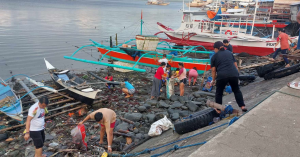
His call fetched results. Hundreds of city and barangay (village) elected officials, national and local government employees, uniformed personnel of the Armed Forces, the National Police, Coast Guard, Fire Protection Bureau, civil society organizations, students and youth, private companies, commercial establishments joined the clean-up operations every Saturday. “We collected more than 500 tons of waste!” says Andrew Manlawe, who heads the city government’s Oplan Linis(Operation Cleanliness).
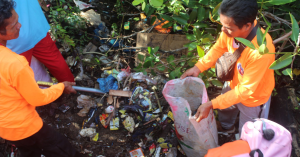
The last clean-up took place on April 22, International Earth Day. The City Environment and Natural Resources Officer, Atty. Carlo Gomez appealed to the residents of the coastal informal settlements to avoid throwing their wastes into the coastal waters, “Do not pollute our bay!” Gomez is never tired of repeating that getting rid of solid wastes from coastal waters can help protect the coastal waters, and the city’s natural environment. “Puerto Princesa’s coastline was pristine and unblemished before the migrants’ shanties started mushrooming here. Therefore, they should not pollute it as a gesture of respect to the locals who welcomed them to settle in this city, he says. His appeal to the settlers is an emotional one: “ Tinanggap namin kayo na maluwalhati sa aming malinis at luntiang bayan. Sana naman po ay suklian ninyo ng paggalangat pag-respeto sa pamamagitan ng kalinisan sa inyongkapaligiran.” (We joyfully accepted you here in our clean and green town. We fervently hope that you will pay back our kindness by respecting us, through maintaining cleanliness in your surrounding).”The red-tide challenge has also invited international solutions. Since 20233, Puerto Princesa is one of the pilot sites of the Clean Cities Blue Ocean (CCBO) of the United States Agency for International Development (USAID). CCBO is USAID’s global flagship program under the Save Our Seas Initiative to address the 11 million metric tons of plastic that flow into the ocean each year.
Healing coastal ecosystems with bioremediation
As one set of officials try to tackle the human causes of water pollution, another is engaged in bioremediation to naturally heal Puerto Princesca’s degraded coastlines. A regular activity of the Office of the City Environment and Natural Resources Office (City ENRO) is to throw EM (Effective Microorganism) mudballs into the bay, to improve the quality of the coastal waters.
Bioremediation is a waste management process using live organisms to neutralize or remove harmful pollutants from contaminated areas. The mudballs work like bombs, exploding millions of good microorganisms into the waters, which dispersed the good work of breaking down red tide toxins and consuming dangerous bacteria.

To ensure that the community can detect presence of HAB, the City Agriculture Office of Puerto Princesa conducts regular monthly monitoring to detect the presence of HAB. The office has 10 water sampling and 4 shellfish sampling stations in Puerto Princesa Bay while in nearby Honda Bay, there are 11 water sampling and 6 shellfish sampling stations.
Delgado explained that if there are 60 micrograms present in shellfish samples of 100 grams, BFAR and the local authorities will then declare presence of HAB or red tide, which a shellfish advisory will be subsequently issued.
Changing land use for good
In a bold move to address the lack of decent shelter for Puerto Princesans, – especially the 7,000 people living along the city’s coastlines, coastal easements, and in mangrove areas – the government, in February 2024, unveiled a housing project that would give Puerto Princesa 47 five-story buildings. The project in Barangay Irawan, about 12 kilometers from downtown Puerto Princesa, would bring the city government closer to its goal of doing away with coastal informal settlements. As early as 2019, the city government acquired a 22-hectare property for their relocation.
About 5,640 housing units would become available under the auspices of the national government’s Pambansang Pabahay para sa Pilipino Program (4PH). Puerto Princesa Mayor Lucilo Bayron called the project a flagship program of the government, funded by the Social Housing Finance Corporation (SHFC), an agency under the Department of Human Settlement and Urban Development (DHSUD).
Bayron said informal settlers, especially those living along the city’s coastlines, would get priority in line with the local government’s campaign to free its coastal areas from pollution. The quality of the bay has been threatened by human activities such as dumping of untreated wastewater, garbage, and even human and animal wastes.” She sums it up: “Aminin natin ang totoo kung ano ang nag-cause ng pollution. Unang una ang indiscriminate na pagtatapon ng basura. Dahil sa mga tao,”(Let’s admit the truth about what has been causing the pollution. Firstly, it’s the indiscriminate dumping of garbage. Because of people.)




















Discussion about this post